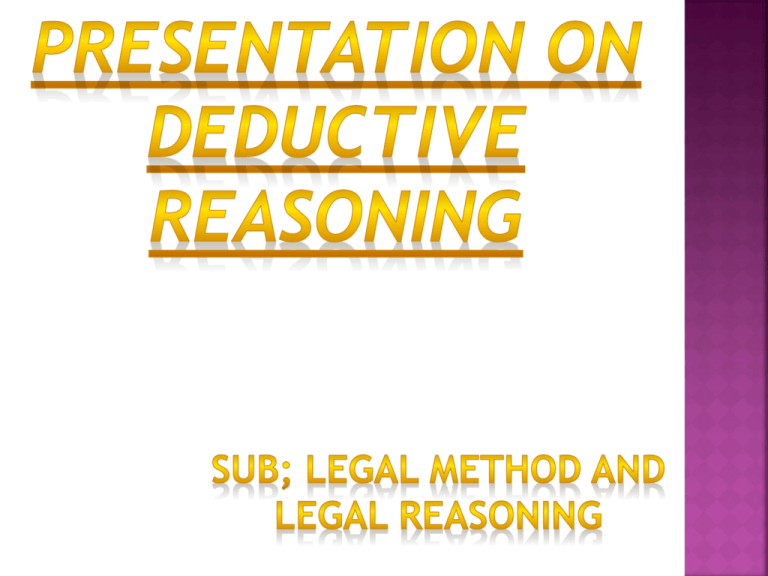
Group MEMBERS ARE •NITIN RANA
•PARIKSHIT GAUR
•PURNENDU
•PuLKITPAL SINGH
•RISHAB RAJ
•RITIKA GAUTAM
Deductive reasoning is sometimes referred to as top-down
logic. Its counterpart, inductive reasoning, is sometimes
referred to as bottom-up logic. Where deductive reasoning
proceeds from general premises to a specific conclusion,
inductive reasoning proceeds from specific premises to a
general conclusion.
The Greek philosopher Aristotle, who is considered the father
of deductive reasoning, wrote the following classic example:
All men are mortal.Socrates is a man.Therefore, Socrates is
mortal.
In Aristotle’s example, sometimes referred to as a syllogism,
the premises of the argument -- that all men are mortal and
that Socrates is a man -- are self-evidently true. Because the
premises establish that Socrates is an individual in a group
whose members are all mortal, the inescapable conclusion is
that Socrates must likewise be mortal.
“DeDuctive reasoning
is a logical process in
which a conclusion is
based on the
concordance of
multiple premises that
are generally
assumeD to be true”.
Two Methods of Reasoning
by Harvey Bluedorn. Copyright 1995. All rights reserved.
An Introduction to Inductive and Deductive Logic
Fixing Flawed Thinking
We often suppose that the other guy's thinking is flawed,
without even considering whether the real problem is
actually with our own thinking. We tend to elevate our
limited observations and our plausible opinions to the
level of sure facts and infallible conclusions. Faith
indeed has a part in logic, but too often we give it the
wrong part. We know what we want to believe, and we
conclude that it therefore must be true. But t’ain’t
necessarily so. We need to recognize what method of
reasoning we are using, and what are the limits of that
method of reasoning.
Two Methods Of Reasoning
Reasoning can run in two
opposite
directions. Deductive reasoning
moves from a general premise
to a more specific
conclusion. Inductive reasoning
moves from specific premises to
a general conclusion. These two
methods of reasoning will
produce two different kinds of
results.
Let's look at inductive reasoning first. Inductive reasoning
moves from the particular to the general. It gathers together
particular observations in the form of premises, then it
reasons from these particular premises to a general
conclusion. The most common form of inductive reasoning is when
we collect evidence of some observed phenomena (e.g.
examining 10,000 dogs for fleas), then we draw a general
conclusion about all such phenomena based on our collected
evidence (e.g. whether all dogs have fleas). In an inductive
argument, the conclusion goes beyond what the premises
actually say. For example, if I observe 10,000 dogs, and every
dog has fleas, I may conclude "All dogs must have fleas." The
conclusion is a conjecture or a prediction. Further evidence
may support or deny my conclusion. The 10,001st dog may not
have fleas. Therefore, with an inductive argument, anyone can
affirm all my premises (10,000 dogs with fleas, yet deny my
conclusion (all dogs have fleas) without involving himself in
any logical contradiction. What I say in my conclusion is
possible, It may even seem very probable. Nevertheless, it is
not a necessary conclusion. If someone said,
"Some dogs may have fleas, but I don't believe all dogs have
fleas," there is no logical response I could make. The logical
certainty of my conclusion is entirely dependent upon my
correct interpretation of the evidence and the consistency of
the evidence with the remainder of the phenomena which was not,
is not, or may never be observed. Maybe I had fleas, and I
inadvertently transferred them to each of the 10,000 dogs, so
the 10,000 dogs actually had no fleas except when I examined
them. I would have to examine all dogs at all times under
thoroughly monitored conditions in order to "prove" my
conclusion. But this would be an impractical task. Therefore it is
unlikely my conclusion will ever be proven. It can, however, be
disproven. Find one dog without fleas. Then you will be left with
the conclusion which I should have arrived at to begin with,
"Some dogs have fleas." Maybe most dogs, or nearly all dogs
have fleas. But all I know for certain is that some dogs have
fleas. Remember, an inductive argument concludes more than the
premises actually warrant.
We use inductive reasoning all of the time. It is very
useful. But we must recognize its limits. Most inductive
reasoning is not based upon exhaustive evidence, and
therefore the form is incomplete. (10,000 dogs is
not all dogs.) Unless the evidence or observations are
exhaustive (I examine all dogs for fleas), the
conclusion is only a guess. It may be a good guess. The
strength of the inductive argument is increased as it
approaches completeness. If the evidence I accept
represents all possibilities within the whole, my
inductive conclusion will be correct. The more I can
demonstrate that the evidence is truly
representative, the more compelling will my
conclusion be. "10,000 dogs of every age and variety
chosen at random from every country on the earth
were examined under controlled conditions, and all of
them had fleas. Therefore, it seems likely that all
dogs have fleas."
Deductive reasoning moves from the general to the particular. It takes
a general premise and deduces particular conclusions. A "valid"
deductive argument is one in which the conclusion necessarily follows
from the premise. (All dogs have fleas. This is a dog. Therefore this dog
has fleas.) The premise may not be "true" but the form of the argument is
nevertheless "valid". (If all dogs do have fleas, and if this is a dog, then
this dog must necessarily have fleas.) An "invalid" deductive argument
will contain something in the conclusion wholly new and independent from
those things mentioned in the premise of the argument. (If all dogs have
fleas, then my dog must have ticks. But ticks are not mentioned in the
premise.) Sometimes it is not so obvious that something new has been
introduced in the conclusion. (Only man is a rational being. Therefore, no
woman is a rational being
Sources of Deductive Premises
If one believes all the premises
in a valid deductive argument, he
must believe the conclusion. The
premise of a deductive argument
may come from several sources.
In order to evaluate the truth of
the deductive argument, it is
important to recognize the
source of its premises.
The conclusion of an inductive argument may be used as the
premise of adeductive argument. The weakness of most
inductive arguments is that they begin with incomplete
premises. (10,000 dogs is not all dogs.) One may arrive at a
false inductive conclusion (All 10,000 dogs examined had
flees, therefore all dogs have fleas.). He may use this false
conclusion as the premise of a valid deductive argument
(Since all dogs have fleas, therefore this dog must have
fleas). If the premise is false, the conclusion is false. (This
dog may indeed have fleas, but it is not a necessary
consequence of the fact that all dogs have fleas, because
all dogs do not necessarily have fleas, only 10,000 dogs had
fleas at the time they were tested.) Scientists commonly
arrive at inductive conclusions on the basis of inadequate
information, then argue deductively from their induction.
Invalid and False Inductive argument:
All living creatures have a
genetic code.
Therefore all living creatures
are genetically related.
Valid but False Deductive
Argument:
All living creatures are genetically
related.
Man is a living creature.
Therefore man is genetically related to all
other living creatures.
If A = B and B = C, then A = C.All apples are fruits, all fruits grow on trees;
therefore, all apples grow on trees.William is a bachelor, all bachelors are single;
hence William is single.Since all humans are mortal, and I am a human, then I am
mortal. All dolphins are mammals, all mammals have kidneys; therefore all
dolphins have kidneys. Since all squares are rectangles, and all rectangles have
four sides, so all squares have four sides. If Dennis misses work and at work
there is a party, then Dennis will miss the party.All numbers ending in 0 or 5 are
divisible by 5. The number 35 ends with a 5, so it is divisible by 5.The Earth is a
planet, and all planets orbit a sun, therefore the Earth orbits a sun.To earn a
master’s degree, a student must have 32 credits. Tim has 40 credits, so Tim will
earn a master’s degree.All birds have feathers and robins are birds, so robins
have feathers.It is dangerous to drive on icy streets. The streets are icy now so it
is dangerous to drive now.All cats have a keen sense of smell. Fluffy is a cat, so
Fluffy has a keen sense of smell.The elm is a tree and all trees have bark, so
elms have bark.Snakes are reptiles and reptiles are cold-blooded; therefore,
snakes are cold-blooded.Cacti are plants and all plants perform photosynthesis;
therefore, cacti perform photosynthesis.Red meat has iron in it and beef is red
meat, so beef has iron in it.Acute angles are less than 90 degrees and this angle
is 40 degrees so this angle is acute.All noble gases are stable and helium is a
noble gas, so helium is stable.Magnolias are dicots and dicots have two
embryonic leaves; therefore magnolias have two embryonic leaves.Elephants
have cells in their bodies and all cells have DNA, so elephants have DNA.All cars
have at least two doors and a Ford Focus is a car, so the Ford Focus has at least
two doors.All horses have manes and the Arabian is a horse; therefore Arabians
have manes.Other Patterns of Deductive Reasoning





